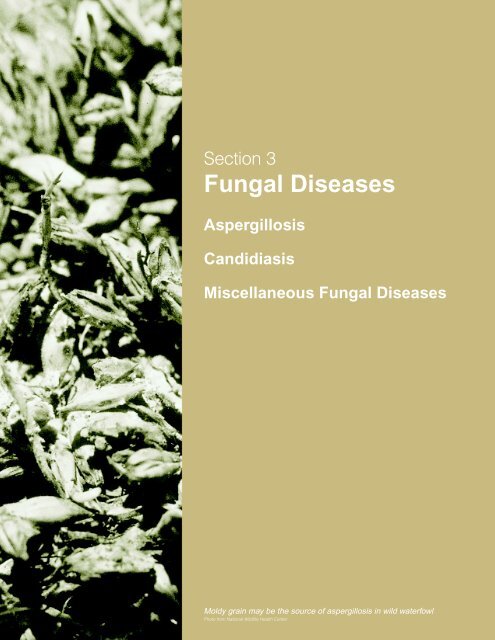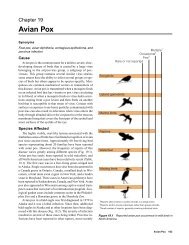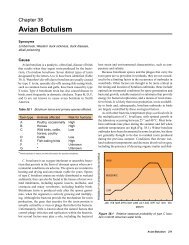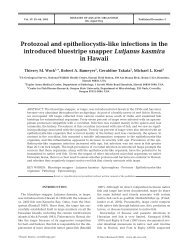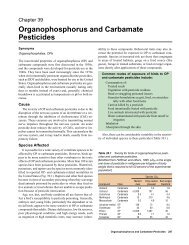Section 3: Fungal Diseases - National Wildlife Health Center
Section 3: Fungal Diseases - National Wildlife Health Center
Section 3: Fungal Diseases - National Wildlife Health Center
You also want an ePaper? Increase the reach of your titles
YUMPU automatically turns print PDFs into web optimized ePapers that Google loves.
<strong>Section</strong> 3<br />
<strong>Fungal</strong> <strong>Diseases</strong><br />
Aspergillosis<br />
Candidiasis<br />
Miscellaneous <strong>Fungal</strong> <strong>Diseases</strong><br />
Introduction to <strong>Fungal</strong> <strong>Diseases</strong> 127<br />
Moldy grain may be the source of aspergillosis in wild waterfowl<br />
Photo from <strong>National</strong> <strong>Wildlife</strong> <strong>Health</strong> <strong>Center</strong>
Introduction to <strong>Fungal</strong> <strong>Diseases</strong><br />
“Fungi are of an ancient lineage and have a fossil record that extends back to the<br />
Devonian and Pre-Cambrian eras…the earliest written record of fungi are not of the<br />
fungi themselves, but of their depredations… To the physician and poet Nicander<br />
[ca. 185 B.C.], fungi were ‘the evil ferment of the earth; poisonous kinds originating<br />
from the breath of vipers,’…”<br />
(Ainsworth)<br />
Fungi are important causes of disease in wild birds and other<br />
species. Three basic types of disease are caused by these<br />
agents: mycosis, or the direct invasion of tissues by fungal<br />
cells, such as aspergillosis; allergic disease involving the<br />
development of a hypersensitivity of the host to fungal antigens;<br />
and mycotoxicosis, which results from ingestion of<br />
toxic fungal metabolites. Mycosis and allergic disease may<br />
occur together, especially when the lung is infected. This<br />
section will address only mycosis. Mycotoxicosis is addressed<br />
in <strong>Section</strong> 6, Biotoxins. Allergic disease is not well<br />
studied in wild birds and it is beyond the scope of this Manual.<br />
Most disease-causing fungi are commonly found within<br />
the normal environment of hosts that may become diseased.<br />
Host resistance is the main determinant of whether or not<br />
disease will occur. Opportunistic infections often result when<br />
birds and other species are immunosuppressed, when their<br />
mechanisms for inflammatory response are inhibited, or when<br />
they experience physical, nutritional, or other stress for prolonged<br />
periods of time. Newborn do not have fully functioning<br />
immune systems and are, therefore, especially vulnerable<br />
to mycosis as are very old animals that are likely to<br />
have impaired immune systems. Inhalation is the primary<br />
route for exposure to most fungi-causing mycosis.<br />
Aspergillosis is the primary mycosis affecting wild birds.<br />
Candidiasis is a less common mycosis of wild birds and other<br />
species, but it differs greatly from aspergillosis by being transmitted<br />
by ingestion. These two diseases are the primary<br />
mycoses of wild birds and are the main subjects of this section.<br />
Quote from:<br />
Ainsworth, G.C., and Sussman, A.S., 1965, The fungi: An<br />
advanced treatise, v. 1 of The <strong>Fungal</strong> Cell: Academic Press,<br />
New York, p. 4, 8.<br />
128 Field Manual of <strong>Wildlife</strong> <strong>Diseases</strong>: Birds


